情景教学法的理论基础
【精品】情景教学法的理论基础

【精品】情景教学法的理论基础情景教学法是一种以情境为基础的教学方法,其理论基础包括认知观念、学习理论、教育心理学和语言学等方面。
1. 认知观念认知观念是情景教学法的理论基础之一。
它认为学习者通过自身经验的积累,形成对世界的认识和理解,并不断调整和修正。
情景教学法的一大特点是创造“真实的情境”,激发学生自主学习的兴趣,促进学习者自主构建知识结构,从而实现“社会化学习”(Vygotsky,1978)。
2. 学习理论情景教学法的理论基础也包括多种学习理论。
其中,行为主义理论认为学习是一种机械的刺激-反应过程;而情景教学法则认为学习是一种个人对不同情境的反应和适应过程,包括模仿、想象、推断和反思等多种认知过程。
同时,认知心理学和建构主义理论也为情景教学法提供了理论支持。
3. 教育心理学教育心理学对于情景教学法的理论基础也具有重要意义。
Gardner(1983)的多元智能理论认为,每个学生都有自己的学习方式和优势智能,情景教学法可以针对学生的不同需求提供个性化的学习体验。
同时,情景教学法也强调学习的情感和态度因素,认为学生需要感受到学习的乐趣和价值,建立积极学习态度。
4. 语言学情景教学法的理论基础还包括语言学方面的支持。
Krashen(1982)的语言习得理论认为,学习者在真实情境中使用语言会更加自然和有效。
情景教学法通过创造真实的情境来促进学生在使用语言时的自然体验,同时也提供了反馈机制,帮助学生改进其语言运用能力。
综上所述,情景教学法的理论基础涉及多个领域,既包括认知心理学、学习理论、教育心理学等教育学领域,也包括语言学领域。
这些理论支持为情景教学法的实践提供了坚实的基础,同时也使情景教学法与其他教学方法区别开来,成为一种特殊的教学体系。
情景教学法教学实践研究(3篇)

第1篇摘要情景教学法是一种以学生为中心的教学方法,通过创设与教学内容相关的真实或模拟情景,激发学生的学习兴趣,提高学生的实践能力和创新能力。
本文通过对情景教学法在教学实践中的应用进行深入研究,探讨其优势、实施策略以及存在的问题,以期为我国教育工作者提供有益的参考。
一、引言随着素质教育的深入推进,教学方法的改革与创新成为教育领域的重要课题。
情景教学法作为一种以学生为主体的教学方法,近年来在我国教育界得到了广泛关注。
本文通过对情景教学法在教学实践中的应用进行深入研究,旨在探讨其优势、实施策略以及存在的问题,为我国教育工作者提供有益的参考。
二、情景教学法优势1. 提高学生学习兴趣情景教学法通过创设与教学内容相关的真实或模拟情景,使学生在情境中学习,激发学生的学习兴趣,提高学生的学习积极性。
2. 培养学生实践能力情景教学法强调学生在情境中的实践操作,有助于培养学生的动手能力、观察能力、分析问题和解决问题的能力。
3. 促进学生创新能力的发展情景教学法鼓励学生在情境中发挥想象力,创新性地解决问题,有利于培养学生的创新意识和创新能力。
4. 提高教学效果情景教学法有助于提高课堂教学效果,使学生在轻松愉快的氛围中掌握知识,提高教学质量。
三、情景教学法实施策略1. 精心设计情景教师应根据教学内容和学生的实际情况,精心设计情景,确保情景的真实性、趣味性和启发性。
2. 注重情境创设教师应运用多媒体技术、实物展示等多种手段,创设与教学内容相关的真实或模拟情景,使学生在情境中感受知识。
3. 调动学生积极性教师应通过提问、讨论、角色扮演等方式,调动学生的积极性,让学生在情境中主动学习。
4. 强化实践操作教师应引导学生进行实践操作,让学生在情境中锻炼自己的动手能力、观察能力、分析问题和解决问题的能力。
5. 注重评价与反馈教师应关注学生在情景教学中的表现,及时给予评价和反馈,帮助学生改进学习方法,提高学习效果。
四、情景教学法存在的问题及对策1. 问题(1)情景设计不合理,缺乏针对性。
幼儿园情景教学法案例

幼儿园情景教学法案例一、案例背景某幼儿园为了提高幼儿的综合能力和兴趣,采用情景教学法进行教学。
本次情景教学内容为“做火车”。
二、情景教学法的理论基础情景教学法是以情景为载体的一种教学方法,其理论基础主要有三个方面:1.认知心理学:情景教学法通过创造真实、具体的情境,让幼儿在情境中感知、体验和认知,从而提升幼儿的学习效果和兴趣。
2.行为主义学派:情景教学法注重教学过程的体验和反馈,让幼儿在情境中有机会进行模仿和实践,从而形成新的行为习惯。
3.社会学习理论:情景教学法强调社会环境对幼儿学习的影响,通过创造有意义的社会情境,让幼儿在情境中学习,从而培养幼儿的社会能力。
三、情景教学法的实施过程1.情境创设为了创造真实的情境,教师在教室里布置了一条小火车轨道,准备好了各种小火车、铁轨、信号灯等道具,还播放了火车行驶的声音。
在教学前,教师通过课件和故事讲解,让幼儿了解火车的基本知识和构成。
2.情境导入教师在幼儿园门口放了一张海报,上面写着“今天我们要一起做火车,谁能找到火车站呢?”幼儿看到海报后,纷纷跑回教室,找到了火车站,开始了做火车的旅程。
3.情境体验教师让幼儿自由选择小火车和铁轨,然后将小火车放在铁轨上,让幼儿亲身体验火车行驶的过程,同时教师通过播放火车行驶的声音,让幼儿感受火车的速度和声音。
4.情境体验反馈为了让幼儿对自己的体验有所反思,教师提出一些问题,如“为什么火车会发出这样的声音?”“你觉得火车为什么这么快?”幼儿通过思考和讨论,逐渐理解了火车的基本知识和构成。
5.情境拓展为了让幼儿对火车有更深入的了解,教师引导幼儿进行相关的手工制作和绘画活动,如制作火车和铁轨的模型、画出自己喜欢的火车等。
四、情景教学法的效果评估在教学结束后,教师对幼儿进行效果评估。
通过观察和问答,教师发现幼儿对火车的基本知识有了更深入的理解,同时幼儿对火车的兴趣也得到了提升。
五、总结情景教学法是一种以情境为载体的教学方法,它可以让幼儿在真实、具体的情境中感知、体验和认知,从而提升幼儿的学习效果和兴趣。
2024年建构主义情景教学法论文
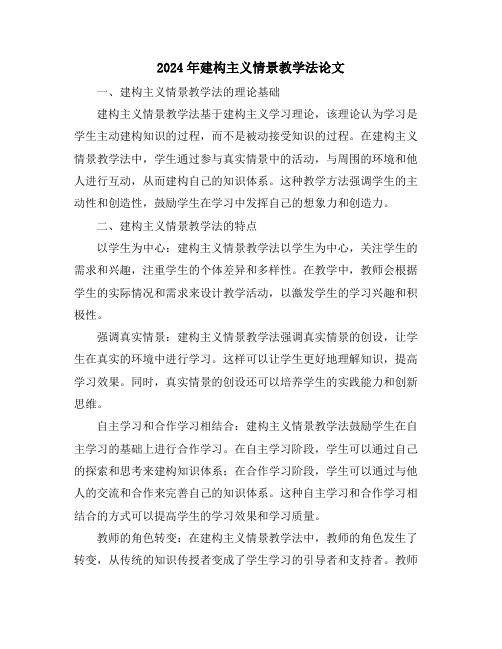
2024年建构主义情景教学法论文一、建构主义情景教学法的理论基础建构主义情景教学法基于建构主义学习理论,该理论认为学习是学生主动建构知识的过程,而不是被动接受知识的过程。
在建构主义情景教学法中,学生通过参与真实情景中的活动,与周围的环境和他人进行互动,从而建构自己的知识体系。
这种教学方法强调学生的主动性和创造性,鼓励学生在学习中发挥自己的想象力和创造力。
二、建构主义情景教学法的特点以学生为中心:建构主义情景教学法以学生为中心,关注学生的需求和兴趣,注重学生的个体差异和多样性。
在教学中,教师会根据学生的实际情况和需求来设计教学活动,以激发学生的学习兴趣和积极性。
强调真实情景:建构主义情景教学法强调真实情景的创设,让学生在真实的环境中进行学习。
这样可以让学生更好地理解知识,提高学习效果。
同时,真实情景的创设还可以培养学生的实践能力和创新思维。
自主学习和合作学习相结合:建构主义情景教学法鼓励学生在自主学习的基础上进行合作学习。
在自主学习阶段,学生可以通过自己的探索和思考来建构知识体系;在合作学习阶段,学生可以通过与他人的交流和合作来完善自己的知识体系。
这种自主学习和合作学习相结合的方式可以提高学生的学习效果和学习质量。
教师的角色转变:在建构主义情景教学法中,教师的角色发生了转变,从传统的知识传授者变成了学生学习的引导者和支持者。
教师需要设计教学活动、提供学习资源、引导学生学习,并在学生遇到困难时给予适当的帮助和支持。
三、建构主义情景教学法的实践应用建构主义情景教学法在实际教学中有着广泛的应用。
例如,在英语教学中,教师可以设计一些真实的语境,如角色扮演、情景对话等,让学生在真实的语境中进行英语学习,提高学生的英语应用能力。
在数学教学中,教师可以设计一些实际问题,如解决实际问题、数学建模等,让学生在解决问题的过程中学习数学,提高学生的数学思维和解决问题的能力。
除了具体的学科教学外,建构主义情景教学法还可以应用于跨学科的学习和项目式学习中。
情景教学法在语文教学中的意义

情景教学法在语文教学中的意义情景教学法在语文教学中的意义徐晓燕内容摘要:在现阶段小学语文教学中采用情景教学法,既能够有效调动学生参与课堂学习的积极性和主动性,还极大地提升教师课堂教学效果和教学质量,因而在课堂教学中占据重要地位。
基于此,本文首先就情景教学法概述以及在小学语文教学中的重要性进行分析,并就其在教学中的具体应用进行重点探析。
关键词:情景教学法小学语文应用在我国的教育领域内,语文教学一直被视为重中之重。
小学生通过语文学习,不仅将体会中国汉语言文化的博大精深,更将通过循序渐进的学习,形成对中国灿烂文化的传承和积累。
此外,小学语文也是重要的奠基学科,语文教学强调对学生理解能力、表达能力、思维意识的综合培养。
因此,只有帮学生打好学习语文的基础,才能实现其未来更高阶段的发展和学习。
区别与传统应试教育的刻板性,现代语文教学不仅更具趣味化,注重对学生学习兴趣的培养,更加注重对教学方式的优化及创新。
以情景化教学为代表,不仅摆脱了定式学习中学生们的死记硬背,通过为学生构建学习情景,使其能够深入了解作者真实情感。
使小学中在理解中增强对语文的学习,在学习中能够不断进步和成长情景教学作为创新性教学方式,在教学中发挥着重要作用,特别是在小学语文教学中,显著提高学生语文学习效果。
因而作为小学语文教师,在开展语文教学中要结合具体教学内容合理应用情景教学法。
一.情景教学法概述根据调查发现,相关学者针对情景教学法定义为具有丰富情感色彩的现代化教学方式,需要教师在教学中根据课程内容与学生进行互动,从而建立良好的互动体验,为学生学习创造出良好的课堂氛围。
1.情景教学是一个形式多样的教学过程教师在教学活动中,需要根据课程内容,适当地引进与之相关的互动场景,进而给学生较为直观的体验。
具体包括:游戏互动、角色扮演等。
这些活动的开展,不仅能增强课堂教学的趣味性,还能进一步提高学生学习语文的效果,进而为后续语文知识的学习奠定良好基础。
情境教学法在初中英语听说教学中的应用研究
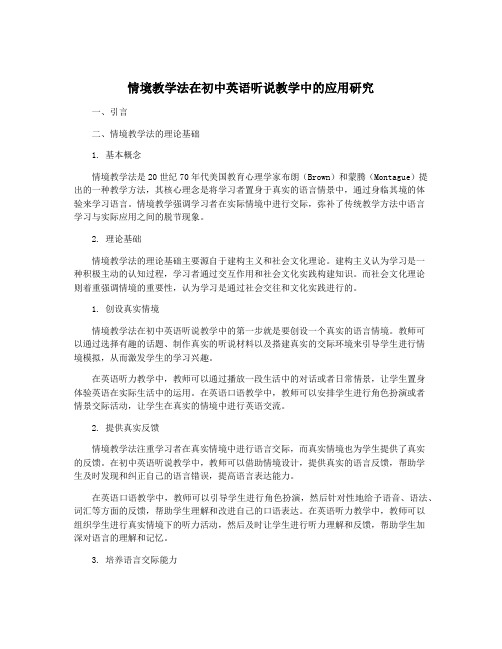
情境教学法在初中英语听说教学中的应用研究一、引言二、情境教学法的理论基础1. 基本概念情境教学法是20世纪70年代美国教育心理学家布朗(Brown)和蒙腾(Montague)提出的一种教学方法,其核心理念是将学习者置身于真实的语言情景中,通过身临其境的体验来学习语言。
情境教学强调学习者在实际情境中进行交际,弥补了传统教学方法中语言学习与实际应用之间的脱节现象。
2. 理论基础情境教学法的理论基础主要源自于建构主义和社会文化理论。
建构主义认为学习是一种积极主动的认知过程,学习者通过交互作用和社会文化实践构建知识。
而社会文化理论则着重强调情境的重要性,认为学习是通过社会交往和文化实践进行的。
1. 创设真实情境情境教学法在初中英语听说教学中的第一步就是要创设一个真实的语言情境。
教师可以通过选择有趣的话题、制作真实的听说材料以及搭建真实的交际环境来引导学生进行情境模拟,从而激发学生的学习兴趣。
在英语听力教学中,教师可以通过播放一段生活中的对话或者日常情景,让学生置身体验英语在实际生活中的运用。
在英语口语教学中,教师可以安排学生进行角色扮演或者情景交际活动,让学生在真实的情境中进行英语交流。
2. 提供真实反馈情境教学法注重学习者在真实情境中进行语言交际,而真实情境也为学生提供了真实的反馈。
在初中英语听说教学中,教师可以借助情境设计,提供真实的语言反馈,帮助学生及时发现和纠正自己的语言错误,提高语言表达能力。
在英语口语教学中,教师可以引导学生进行角色扮演,然后针对性地给予语音、语法、词汇等方面的反馈,帮助学生理解和改进自己的口语表达。
在英语听力教学中,教师可以组织学生进行真实情境下的听力活动,然后及时让学生进行听力理解和反馈,帮助学生加深对语言的理解和记忆。
3. 培养语言交际能力。
情景教学法的实践方式(3篇)
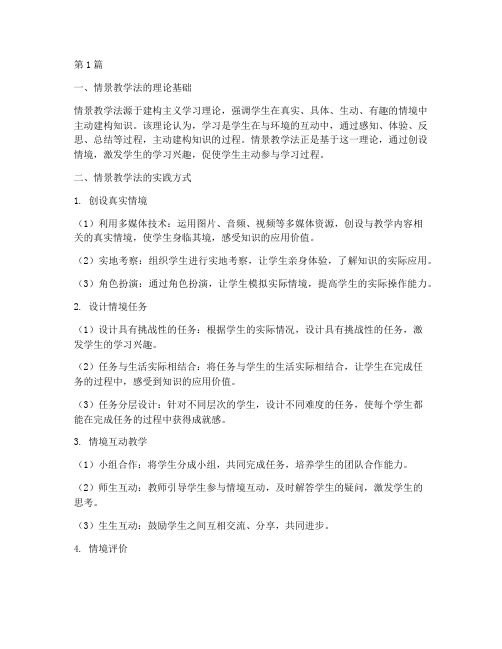
第1篇一、情景教学法的理论基础情景教学法源于建构主义学习理论,强调学生在真实、具体、生动、有趣的情境中主动建构知识。
该理论认为,学习是学生在与环境的互动中,通过感知、体验、反思、总结等过程,主动建构知识的过程。
情景教学法正是基于这一理论,通过创设情境,激发学生的学习兴趣,促使学生主动参与学习过程。
二、情景教学法的实践方式1. 创设真实情境(1)利用多媒体技术:运用图片、音频、视频等多媒体资源,创设与教学内容相关的真实情境,使学生身临其境,感受知识的应用价值。
(2)实地考察:组织学生进行实地考察,让学生亲身体验,了解知识的实际应用。
(3)角色扮演:通过角色扮演,让学生模拟实际情境,提高学生的实际操作能力。
2. 设计情境任务(1)设计具有挑战性的任务:根据学生的实际情况,设计具有挑战性的任务,激发学生的学习兴趣。
(2)任务与生活实际相结合:将任务与学生的生活实际相结合,让学生在完成任务的过程中,感受到知识的应用价值。
(3)任务分层设计:针对不同层次的学生,设计不同难度的任务,使每个学生都能在完成任务的过程中获得成就感。
3. 情境互动教学(1)小组合作:将学生分成小组,共同完成任务,培养学生的团队合作能力。
(2)师生互动:教师引导学生参与情境互动,及时解答学生的疑问,激发学生的思考。
(3)生生互动:鼓励学生之间互相交流、分享,共同进步。
4. 情境评价(1)过程性评价:关注学生在情境互动过程中的表现,如参与度、合作能力、问题解决能力等。
(2)结果性评价:关注学生完成任务的结果,如知识掌握程度、实际操作能力等。
(3)多元评价:结合学生的自我评价、同伴评价、教师评价等多方面因素,全面评价学生的学习成果。
5. 情境教学反思(1)教师反思:教师对情境教学的效果进行反思,总结经验,改进教学方法。
(2)学生反思:引导学生对情境教学进行反思,提高学生的自我认知能力。
(3)家长参与:鼓励家长参与情境教学,共同关注学生的学习成长。
情景模拟教学法

情景模拟教学法情景模拟教学法是一种以模拟真实情境为基础的教学方法,通过创造真实的学习环境,让学生通过体验和实践来获取知识和技能。
本文将从理论和实践两个方面来探讨情景模拟教学法的优点和应用。
一、理论基础情景模拟教学法的理论基础主要源自于建构主义学习理论和认知心理学的相关研究。
建构主义认为,学习是建构个体知识结构的过程,学生通过与真实情境的互动来主动构建意义。
而认知心理学研究表明,人们在情境中的学习更容易被记忆和应用。
基于这些理论,情景模拟教学法应运而生。
二、优点和价值情景模拟教学法具有以下几个优点和价值。
1. 提高学习效果情景模拟教学法能够将抽象的概念转化为具体的实践操作,让学生更加深入地理解和掌握知识。
通过在真实情境中的模拟,学生能够将理论与实践相结合,更容易理解和应用所学内容,进而提高学习效果。
2. 培养实践能力情景模拟教学法注重学生的实践操作,激发学生的学习兴趣和积极性,培养其实践能力。
学生在真实情境中扮演不同角色,面对多样化的问题和挑战,通过亲身经历和解决问题的过程,能够培养学生的实践能力和创新思维。
3. 增强团队合作意识情景模拟教学法通常需要学生分组合作完成任务,此过程可以增强学生的团队合作意识和协作能力。
学生需要相互协作、分工合作,在面对困难和挑战时共同解决问题,从而提高他们的团队意识和合作精神。
4. 创造真实学习环境情景模拟教学法可以创造出与真实情境相似的学习环境,让学生对知识进行真实应用和实践。
例如,在商业学习中,可以通过模拟商务谈判、市场竞争等情景,让学生在真实的商业环境中获取经验和技能。
三、应用案例情景模拟教学法在各个学科和领域都有广泛的应用。
以下是几个实际案例。
1. 医学教育医学院通常会采用情景模拟教学法来训练学生的临床技能。
通过模拟真实的医学情境,如急救场景、手术模拟等,让学生在模拟情境中进行实际操作和决策,提高他们的临床技能和应变能力。
2. 商业培训在商业培训中,情景模拟教学法可以帮助学员模拟真实商业情况,如销售谈判、团队管理等。
利用情景教学法提升学生的语言表达能力

利用情景教学法提升学生的语言表达能力情景教学法是一种通过创设真实情境来促进学生语言表达能力提高的教学方法。
它能够让学生在实际的交流场景中进行语言的运用,提高学生的听说读写能力。
本文将探讨如何利用情景教学法来提升学生的语言表达能力,并给出一些具体的实施方法。
一、背景介绍如今,随着全球化和信息技术的迅猛发展,语言表达能力对于学生来说越来越重要。
在职场和社交中,流利的语言表达能力能给人留下良好的印象, 同时也有助于有效地沟通交流。
而传统的教学方法往往只注重知识的灌输,对于学生的交际能力提升有一定的局限性。
因此,采用情景教学法来提升学生的语言表达能力具有重要意义。
二、情景教学法的理论基础情景教学法的核心理论是建构主义学习理论。
它认为学习是通过主动积极地参与学习活动来实现的。
情景教学法强调将学习活动设计成真实的情境,让学生在情境中感受和运用语言。
这样一来,学生可以更加积极主动地参与学习,激发他们的学习兴趣和动力。
三、实施情景教学法的方法1. 设计真实情境:在教学中,教师可以创设真实的情境来让学生进行语言表达。
比如,模拟饭店点餐的场景,让学生扮演服务员和客人的角色,进行实际的对话练习。
这样可以让学生感受到真实场景中的语言应用,提高他们的语言表达能力。
2. 提供实际材料:教师可以通过使用真实的材料来帮助学生提升语言表达能力。
比如,给学生看一段真实的新闻报道或者观看一部真实的电影,然后安排学生进行讨论和写作,引导他们运用所学的语言知识进行表达。
3. 提供角色扮演机会:角色扮演是情景教学法中的一种重要方法。
教师可以设计一些情境,让学生扮演不同的角色进行对话和表演。
比如,学生可以扮演医生和患者,学习如何进行医学交流,提高专业的语言表达能力。
4. 激发学生的兴趣:教师可以通过设置游戏和竞赛等形式来激发学生的兴趣,促使他们积极参与语言表达活动。
比如,教师可以设计一个角色扮演的比赛,让学生在比赛中展示自己的语言表达能力,并给予奖励和激励。
情景教学法在初中英语口语教学中的应用性研究
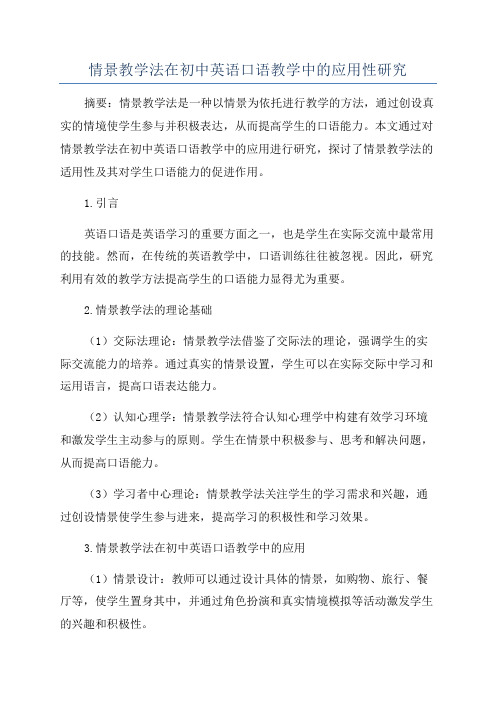
情景教学法在初中英语口语教学中的应用性研究摘要:情景教学法是一种以情景为依托进行教学的方法,通过创设真实的情境使学生参与并积极表达,从而提高学生的口语能力。
本文通过对情景教学法在初中英语口语教学中的应用进行研究,探讨了情景教学法的适用性及其对学生口语能力的促进作用。
1.引言英语口语是英语学习的重要方面之一,也是学生在实际交流中最常用的技能。
然而,在传统的英语教学中,口语训练往往被忽视。
因此,研究利用有效的教学方法提高学生的口语能力显得尤为重要。
2.情景教学法的理论基础(1)交际法理论:情景教学法借鉴了交际法的理论,强调学生的实际交流能力的培养。
通过真实的情景设置,学生可以在实际交际中学习和运用语言,提高口语表达能力。
(2)认知心理学:情景教学法符合认知心理学中构建有效学习环境和激发学生主动参与的原则。
学生在情景中积极参与、思考和解决问题,从而提高口语能力。
(3)学习者中心理论:情景教学法关注学生的学习需求和兴趣,通过创设情景使学生参与进来,提高学习的积极性和学习效果。
3.情景教学法在初中英语口语教学中的应用(1)情景设计:教师可以通过设计具体的情景,如购物、旅行、餐厅等,使学生置身其中,并通过角色扮演和真实情境模拟等活动激发学生的兴趣和积极性。
(2)语言输入:教师可以通过播放录音或视频等方式提供真实的语言输入,让学生感受到真实的语言环境,从而激发学生的口语表达欲望。
(3)情景对话:通过情景对话的形式,让学生在具体情境中进行对话练习,培养学生的口语交际能力。
教师可以引导学生进行角色扮演,提供反馈和纠正错误,以帮助学生改进口语表达。
(4)情景演讲:让学生在真实情境中进行演讲,如模拟会议、口头报告等,让学生在情景中展示口语表达能力,提高自信心和流利度。
4.情景教学法在初中英语口语教学中的效果(1)提高学生的口语流利度:通过情景教学法的应用,学生在真实情境中积极参与口语表达,提高了语言输出的频率和流利度。
情境教学法的理论基础_情境教学的理论框架
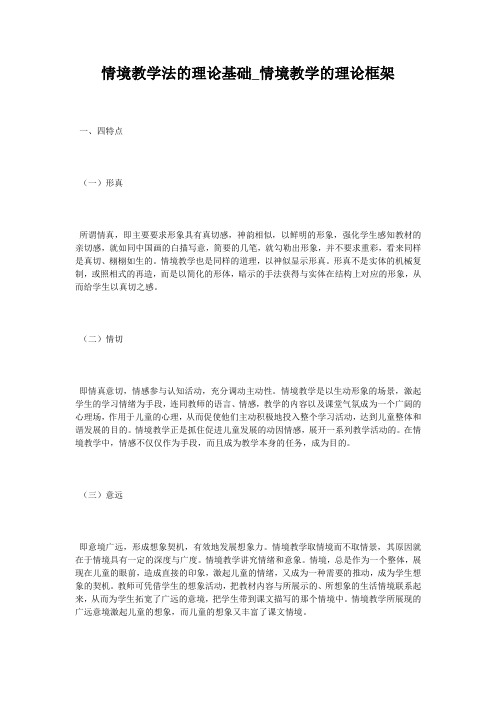
情境教学法的理论基础_情境教学的理论框架一、四特点(一)形真所谓情真,即主要要求形象具有真切感,神韵相似,以鲜明的形象,强化学生感知教材的亲切感,就如同中国画的白描写意,简要的几笔,就勾勒出形象,并不要求重彩,看来同样是真切、栩栩如生的。
情境教学也是同样的道理,以神似显示形真。
形真不是实体的机械复制,或照相式的再造,而是以简化的形体,暗示的手法获得与实体在结构上对应的形象,从而给学生以真切之感。
(二)情切即情真意切,情感参与认知活动,充分调动主动性。
情境教学是以生动形象的场景,激起学生的学习情绪为手段,连同教师的语言、情感,教学的内容以及课堂气氛成为一个广阔的心理场,作用于儿童的心理,从而促使他们主动积极地投入整个学习活动,达到儿童整体和谐发展的目的。
情境教学正是抓住促进儿童发展的动因情感,展开一系列教学活动的。
在情境教学中,情感不仅仅作为手段,而且成为教学本身的任务,成为目的。
(三)意远即意境广远,形成想象契机,有效地发展想象力。
情境教学取情境而不取情景,其原因就在于情境具有一定的深度与广度。
情境教学讲究情绪和意象。
情境,总是作为一个整体,展现在儿童的眼前,造成直接的印象,激起儿童的情绪,又成为一种需要的推动,成为学生想象的契机。
教师可凭借学生的想象活动,把教材内容与所展示的、所想象的生活情境联系起来,从而为学生拓宽了广远的意境,把学生带到课文描写的那个情境中。
情境教学所展现的广远意境激起儿童的想象,而儿童的想象又丰富了课文情境。
(四)理寓其中即蕴涵理念,抽象的理念伴随着形象,有效地提高认识力。
情境教学的理寓其中,就是从教材中心出发,由教材内容决定情境教学的形式。
在教学过程中,创设一个或一组围绕教材中心展现的具体情境。
情境教学理蕴的特点,决定了儿童获得的理念,是伴随着形象与情感的,是有血有肉的。
这不仅是感性的、对事物现象的认识,而且是对事物本质及其相互关系的认识。
情境教学正是具有以上所说的有形、有情、意境广远且理寓其中的特点,使它为学生学习语文,并通过学习语文促进诸方面的发展,提供了一条有效的途径。
教育中的情景教学法

教育中的情景教学法教育中的情景教学法是一种基于实践和体验的教学模式,通过在真实的情境中创造学习机会,帮助学生主动参与和积极探索知识。
这种教学方法不仅提供了一种互动式的学习环境,还促进了学生的主动思考和问题解决能力的培养。
本文将从理论与实践两个方面阐述教育中的情景教学法的重要性和效果。
一、理论基础情景教学法是基于认知心理学理论而发展起来的一种教学策略。
它强调学习者本身的参与和探索,认为学生通过与真实情景的互动,能够更好地理解和应用所学的知识。
此外,情景教学法还注重将学习和实践结合起来,使学生能够在真实情境中运用所学的知识解决问题。
二、实践案例在现实生活中的教育场景中,情景教学法得到了广泛的应用。
例如,在语言教学中,教师可以通过模拟真实情景,让学生进行角色扮演,以提高他们的口语表达能力。
在科学实验教学中,教师可以组织学生进行实际的实验操作,让他们亲自去观察和探究现象,并从中总结出规律和结论。
三、教学效果情景教学法对学生的学习效果有着显著的提升作用。
首先,它能够激发学生的学习兴趣和动力。
通过创造真实的情境,学生能够更好地与所学知识进行连接,形成对知识的渴望和需求。
其次,情景教学法能够促进学生的思考和解决问题的能力。
在真实情景中,学生需要自主思考和探究,从而培养了他们的问题解决能力和创新思维。
此外,情景教学法还能够增强学生的记忆力和应用能力,因为他们在真实情境中所学的知识更加具有实用性和可操作性。
四、挑战与应对尽管情景教学法在教育中有着显著的优势,但也面临一些挑战。
首先,情景教学法需要教师具备丰富的专业知识和教学经验,才能够有效地组织和指导学生进行情景教学。
其次,情景教学法对学校和教师的资源投入要求较高,需要提供适当的场地、设备和材料。
最后,情景教学法的实施需要充分的时间和耐心,因为学生需要在真实情境中进行体验和探索,这需要较长的时间和不断的反复实践。
总结起来,教育中的情景教学法是一种重要的教学方法。
它通过创造真实的情境,让学生在实践中学习和探索,提高了他们的学习兴趣和动力,培养了他们的问题解决能力和创新思维。
浅议情景教学法的理论基础

浅议情景教学法的理论基础一、本文概述在当前教育领域,教学方法的革新与改进一直是研究与实践的热点。
情景教学法作为一种具有创新性和实效性的教学方法,已在教学实践中得到了广泛的应用。
本文旨在浅议情景教学法的理论基础,通过对情景教学法的发展历程、核心理念、理论基础进行深入探讨,以期为教育工作者提供一种新的视角和思考方式,推动教学方法的不断优化与创新。
文章首先将对情景教学法进行简要的介绍,阐述其在教学实践中的应用现状和发展趋势。
接着,将重点分析情景教学法的理论基础,包括建构主义理论、认知灵活性理论、情境认知与学习理论等,揭示情景教学法与这些理论之间的内在联系。
文章将总结情景教学法的优势与局限性,并提出未来研究方向,以期为情景教学法的进一步发展和完善提供有益参考。
二、情景教学法的理论基础情景教学法,作为一种旨在促进学习者全面发展的教学方法,其理论基础是多方面的,涵盖了教育学、心理学、社会学等多个学科领域。
本节将重点探讨情景教学法在教育理论和心理学理论方面的依据。
建构主义是情景教学法的重要理论基础之一。
建构主义者认为,知识不是通过教师传授得到的,而是学习者在一定的情境下,借助他人的帮助,利用必要的学习资料,通过意义建构的方式而获得的。
情景教学法强调在教学中创设真实或仿真的情境,让学生在情境中通过实践、探索、交流等主动学习过程,建构自己的知识体系。
情境认知理论认为,认知过程是与情境紧密相连的,知识存在于具体的、情境性的、可感知的活动之中。
学习应该发生在与现实情境相类似的环境中,通过参与真实情境中的活动和社会互动,学习者能够更好地理解知识,并能够将所学知识应用于实际生活中。
情景教学法正是基于这一理论,通过模拟或真实的情境,使学生在情境中体验和学习,提高学习的实用性和有效性。
人本主义学习理论强调学习者的主体性和自我实现。
人本主义者认为,学习是一个个体自我实现的过程,教育的目标应该是促进学生的全面发展,包括认知、情感、价值观等方面。
情景教学法思考心得体会

随着教育改革的不断深入,各种新的教学方法应运而生,其中情景教学法因其独特的魅力和实效性,受到了广大教育工作者的青睐。
作为一名教育工作者,我有幸在实际教学中尝试运用情景教学法,并在实践中不断反思和总结,现将我的心得体会分享如下。
一、情景教学法的理论基础情景教学法源于苏联心理学家洛扎诺夫的暗示教学理论。
该理论认为,在轻松愉快的氛围中,通过情景的创设,可以激发学生的学习兴趣,提高学习效率。
情景教学法强调在教学中创设一个与教学内容相关的、生动有趣的情景,让学生在情景中学习,从而提高学生的认知能力和实践能力。
二、情景教学法的实施策略1. 精心设计情景情景教学法的核心在于情景的创设。
在设计情景时,教师应充分考虑以下因素:(1)与教学内容紧密结合:情景应围绕教学内容展开,使学生在情景中自然地接触到知识。
(2)生动有趣:情景应具有趣味性,激发学生的学习兴趣。
(3)贴近生活:情景应贴近学生的生活实际,让学生在情景中感受到知识的实用性。
(4)层次分明:情景应具有层次性,满足不同层次学生的学习需求。
2. 创设真实情景真实情景的创设有助于提高学生的认知能力和实践能力。
在实际教学中,教师可以采取以下措施:(1)利用多媒体技术:通过图片、视频、音频等多种形式,将教学内容呈现给学生,使情景更加生动。
(2)组织实践活动:让学生亲身参与实践活动,感受知识的魅力。
(3)开展角色扮演:让学生在角色扮演中,体验不同角色的情感,提高学生的沟通能力和表达能力。
3. 激发学生情感体验情感体验是情景教学法的关键。
教师应关注学生的情感需求,激发学生的情感体验,具体措施如下:(1)营造轻松愉快的氛围:教师应关注学生的情绪变化,尽量营造一个轻松愉快的氛围。
(2)尊重学生个性:教师应尊重学生的个性,关注学生的兴趣和特长,使学生在情景中找到自己的价值。
(3)引导学生反思:在情景结束后,教师应引导学生反思,总结自己的学习收获。
三、情景教学法的反思与体会1. 提高了学生的学习兴趣通过情景教学法的实施,我发现学生的学习兴趣得到了明显提高。
浅议情景教学法的理论基础

情景教学法是一种以情景为基础的教学方法,它把语言学习环境与真实使用语言的情景紧密结合起来,让学生在学习语言的过程中更好地掌握语言的技能。
情景教学法的理论基础主要来源于积极参与理论、语言学习理论、语用学理论、社会交往理论等。
积极参与理论认为,语言学习者需要有效地参与语言活动,只有通过实际参与,才能有效地掌握语言技能。
语言学习理论强调,语言学习是一种社会交往的过程,学习者需要不断地接触语言,把语言学习环境与真实使用语言的情景紧密结合起来,才能有效地学习语言。
语用学理论认为,语言学习不仅仅是学习语言知识,更重要的是学习如何使用语言,这种使用必须基于真实的语言使用情境,才能发挥出最大的效果。
最后,社会交往理论认为,语言学习者需要在社会交往中不断积累经验,才能有效地学习语言。
因此,情景教学法的理论基础主要来源于积极参与理论、语言学习理论、语用学理论、社会交往理论等,它旨在把语言学习环境与真实使用语言的情景紧密结合起来,让学生在学习语言的过程中更好地掌握语言的技能。
近年情景教学法文献综述

近年情景教学法文献综述情景教学法是将现代教育理论和方法引入中国课堂的一种新的教学方法。
它以儿童喜闻乐见的形式将教学过程与儿童在成长过程中所面临的问题进行交朋友,使儿童体验到一种“与学生共同成长”、“生活真实的生活经验,获得知识”和“学习能力会得到极大提高”。
随着课程改革的深入,情景教学法在中小学语文课堂中逐步应用。
然而,由于早期情景教学法对儿童行为存在较大局限,情景教学法尚未得到广泛应用。
本文结合近年来国内学者进行的相关研究,将目前所学到的相关研究成果进行总结。
一、情景教学法的理论基础小学语文课堂上,教师应当以儿童视角审视教书育人中的重点与难点,将课堂上的课堂行为表现作为观察重点,以更好地了解儿童在课堂上的表现。
因此,在小学生语文课堂中运用典型的情境设计与问题引导方法将有助于小学语文课堂更好地开展。
情境设计与问题引导是指在小学语文课堂教学中教师应该以儿童视角审视教材、以儿童思维特点来设计教材、以儿童语言风格来设计课文标题、以儿童阅读能力和表达能力来设计课堂内容等一系列内容,从而帮助小学生理解语文课学习目标及相应的要求。
在情景设计过程中,教师应以儿童视角来选择教材,以儿童思维特点来设计课堂内容等。
目前,有很多研究学者认为情景教育理论中“角色”这一概念较好地解释了如何将教学过程变为一个“儿童自我探索与体验”的过程(Liu& Hong Meyer,2011)。
教师在为儿童设计课程时可以根据儿童学习经验和认知特点,以问题为线索、以情景(情境)为依托、利用多种语言手段进行沟通或协作等方式进行课程设计(郑丽娟等,2014)。
1、儿童视角下的语文学习在语文教学过程中,教师应通过儿童视角审视课堂教学内容,充分了解孩子在学习中的心理需求,尊重孩子学习的内在规律,并根据这些规律来确定课堂学习的重点与难点。
此外,教师还应根据儿童自身对语文课程学习规律的认知能力与语言能力进行合理地设计教学内容(McKinsey& Visci,2016)。
情景教学法的实践依据(3篇)

第1篇一、引言情景教学法是一种以学生为中心的教学方法,通过创设具有真实性和情境性的教学环境,激发学生的学习兴趣,培养学生的实践能力和创新精神。
随着教育改革的不断深入,情景教学法在教育教学中的应用越来越广泛。
本文将从以下几个方面阐述情景教学法的实践依据。
二、情景教学法的理论基础1.建构主义理论建构主义理论认为,知识不是通过教师传授得到的,而是学生在一定的情境中,借助他人的帮助,通过意义建构的方式获得的。
情景教学法正是基于这一理论,通过创设真实情境,引导学生主动参与、积极探究,从而实现知识的建构。
2.认知心理学理论认知心理学理论关注个体的认知过程,认为学习是一个主动建构的过程。
情景教学法通过创设情境,激发学生的认知需求,促使学生主动参与学习,提高学习效果。
3.人本主义理论人本主义理论强调人的全面发展,关注学生的个性、情感和价值观的培养。
情景教学法通过创设具有情感色彩的教学情境,引导学生关注自身情感体验,培养其积极的人生态度和价值观。
三、情景教学法的实践依据1.情境对学习效果的影响(1)情境有助于激发学生的学习兴趣。
真实、生动的情境能够激发学生的学习兴趣,使学生产生强烈的学习动机,从而提高学习效果。
(2)情境有助于学生理解知识。
在情境中,学生能够将抽象的知识与具体的事物相结合,提高对知识的理解和掌握。
(3)情境有助于培养学生的实践能力。
情景教学法强调学生的实践操作,有助于提高学生的动手能力和创新能力。
2.情境创设的原则(1)情境的真实性。
真实情境能够使学生产生共鸣,提高学习效果。
(2)情境的趣味性。
趣味性情境能够激发学生的学习兴趣,使学生在轻松愉快的氛围中学习。
(3)情境的针对性。
针对不同学科特点和学生需求,创设具有针对性的情境。
(4)情境的适度性。
情境不宜过于复杂,以免分散学生注意力,影响学习效果。
3.情境创设的方法(1)实物情境。
利用实物、模型等直观教具,创设真实情境。
(2)图片情境。
利用图片、图表等视觉元素,创设生动情境。
情境教学法在高中化学教学中的运用

情境教学法在高中化学教学中的运用情境教学法是一种注重学生参与、以情境为载体的教学方法,它通过营造真实的生活情境,让学生在实际操作中学习和探究知识,从而提高学生的学习兴趣和学习动力。
在高中化学教学中,情境教学法的应用能够激发学生对化学知识的兴趣,帮助学生更好地理解和掌握抽象的化学概念,促进学生的创新思维和实践能力的培养。
本文将从情境教学法的理论基础、高中化学教学现状、情境教学法在高中化学教学中的具体应用以及存在的问题和对策等方面展开论述。
一、情境教学法的理论基础情境教学法起源于20世纪60年代的美国,是一种以“活动中学习”为核心理念的教学法,其理论基础主要包括认知心理学、建构主义学习理论和情感教育理论等。
认知心理学认为学习者的认知结构是由外界刺激和个体内部处理所形成的,情境教学法通过创设与学习者日常生活和学习实际相关的情境,促使学生主动参与、思考和解决问题,从而深化对知识的理解和掌握。
建构主义学习理论认为学习是一种积极主动的构建过程,情境教学法强调学生的参与和主体性,通过让学生在真实情境中进行操作和实践,使学习更加具体和感性化,有助于学生对知识的内化和个性化。
情感教育理论则提出了“情感教育是教育的灵魂”这一观点,情境教学法强调利用生活实践中的情境,激发学生学习的兴趣和情感投入,促使学生更好地在情感的共鸣中理解和接受知识。
二、高中化学教学现状随着高中化学教学改革的不断深化,传统的讲授式教学已经不能满足学生个性化发展和自主学习的需求。
在传统教学中,化学知识的抽象性、晦涩难懂的表达方式以及缺乏生活情境的应用,使得学生对化学知识缺乏实际应用和深刻理解,学习兴趣不高,学习动力不足。
学生普遍缺乏实验操作和实践经验,不能真正理解化学知识的本质和意义,无法将抽象的化学概念与实际生活相结合,导致学习效果不佳。
1. 创设情境化学实验在化学实验教学中,可以根据学生的实际生活经验和感兴趣的话题,设计具有情境化学实验性的实验。
情景教学法的国内外研究现状

情景教学法的国内外研究现状
情景教学法(situational teaching)是一种以情境为基准的教学模式,强调学习者在真实或仿真的环境中主动参与学习。
学习者通过在特定情境下的实践和应用,来掌握和应用知识、技能和解决问题的能力。
以下是对情景教学法国内外研究现状的综述。
国外研究现状:
1.理论基础:情景教学法源于美国教育心理学家杜威的《经验与教育》。
在20世纪60年代,情景教学法开始被广泛关注和探讨。
2.研究方法:国外的研究主要采用定量研究方法,通过实验和问卷调查等方式,来验证情景教学法对学习成绩和学习兴趣的影响。
3.影响因素:研究发现,情景教学法的有效性与情境的真实性和丰富性、学习者的先前知识水平和个体差异等因素有关。
4.效果评估:大多数研究表明,采用情景教学法可以提高学习者的学习成绩和学习兴趣,并且能够促进学习者的综合能力和问题解决能力的发展。
国内研究现状:
1.发展历程:20世纪80年代,情景教学法开始进入中国,广泛应用于教育教学领域。
此后,国内许多教育机构和研究者开始关注和研究情景教学法。
2.应用领域:情景教学法在国内被广泛运用于各级各类学校,尤其是中小学教育,并涉及到语言教育、科学教育、信息技术教育等多个学科领域。
3.效果研究:国内的研究主要采用定量和定性相结合的方法,通过比较实验和调查研究等方式,来评估情景教学法的效果。
4.研究成果:一些国内的研究发现,情景教学法能够提高学生的学习动机和学习兴趣,促进学生的学习成果和能力的发展。
创设情景教学法在小学语文教学中的应用

创设情景教学法在小学语文教学中的应用一、引言语文教学是小学教育中非常重要的一部分,它不仅仅是学习汉字、阅读文章,更是培养孩子的语言表达能力、阅读能力和写作能力。
在传统的语文教学中,老师往往以讲授知识为主,学生则以接受知识为主,课堂显得枯燥乏味,学生学得也并不积极。
为了提高小学语文教学的效果,创设情景教学法成为了一种新的教学方式。
本文将从情景教学法的理论基础、在小学语文教学中的应用以及实施过程中需要注意的问题等方面进行分析和探讨。
二、情景教学法的理论基础情景教学法起源于美国,它是以不同的情景进行的一种教学法,通过情景的创设和角色扮演等方式,让学生在真实的场景中学习,以达到更好的教学效果。
情景教学法的理论基础主要包括三个方面:建构主义理论、认知理论和情感体验理论。
首先是建构主义理论。
建构主义理论认为,学习是一种积极的参与过程,学习者通过观察、实践、思考与总结来建构自己的知识结构。
在情景教学法中,学生通过参与情境中的角色扮演和实践活动,积极地参与到学习中去,促进了学生的知识建构。
其次是认知理论。
认知理论认为,学习是一种认知过程,学生通过对经验的观察、分析、对比与总结来理解和掌握知识。
在情景教学法中,学生通过扮演角色、模拟情景,能够更好地理解和掌握知识,使得学习更加活跃和有效。
最后是情感体验理论。
情感体验理论认为,学习是一种情感体验的过程,学生通过情感体验来吸收和掌握知识。
情景教学法通过创设不同的情景和角色,让学生能够在情感上更深刻地体验和理解知识,增强学生对知识的体验和记忆。
1. 文字情境创设。
在小学语文教学中,老师可以通过讲故事、播放视频等方式,给学生创设一个具体的情景,帮助学生了解和理解文章中的情感和意境,促进学生对文章的理解和记忆。
2. 角色扮演。
老师可以设计一些小品、情景剧等活动,让学生扮演其中的角色,帮助学生更好地理解文章中的人物形象、语言特点和情感表达,从而提高学生的语言表达能力。
3. 情景模拟。
- 1、下载文档前请自行甄别文档内容的完整性,平台不提供额外的编辑、内容补充、找答案等附加服务。
- 2、"仅部分预览"的文档,不可在线预览部分如存在完整性等问题,可反馈申请退款(可完整预览的文档不适用该条件!)。
- 3、如文档侵犯您的权益,请联系客服反馈,我们会尽快为您处理(人工客服工作时间:9:00-18:30)。
Frame work
2020/3/4
Background
The origins of this approach began with the work of Britlsh applied linguists in the 1920s and 1930s.
The theory that knowledge of structures must be linked to situations in which they could be used gave Situational Language Teaching one of its distinctive features.
Our principal classroom activity in the teaching of English structure will be the oral practice of structures. This oral practice of controlled sentence patterns should be given in situations designed to give the greatest amount of practice in English speech to the pupil
Accuracy in both pronunciation and grammar is regarded as crucial, and errors are to be avoided.
Automatic control of basic structures and sentence patterns is fundamental to reading and writing skills, and this is achieved through speech work.
• GROUP 3: TEACHING ENGLISH GY: SITUATIONAL LANGUAGE TEACHING METHOD
• GROUP MEMBERS:
Background The main characteristics of the approach Theory of language Theory of learning The objectives of the Situational Language
Beginning at this time, a number of outstanding applied Linguists developed the basis for a principled approach to methodology in language teaching.
Two of the leaders in this movement were Harold Palmer and A. S. Hornby, two of the most prominent figures in British twentiethcentury language teaching.
Theory of Language
The theory of language underlying Situational Language Teaching can be characterized as a type of British “structuralism.” Speech was regarded as the basis of language, and structure was viewed as being at the heart of speaking ability.
What they attempted was to develop a more scientific foundation for an oral approach to teach English than was evidenced in the Direct Method.
The main characteristics of the approach
+ Language teaching begins with the spoken language.
+ Material is taught orally before it is presented in written form.
+ The target language is the language of the classroom
The objectives of the Situational Language Teaching method
The objectives of the Situational Language Teaching method are to teach a command of the four basic skills of language, but the skills are approached through structure.
+ New language points are introduced and practiced situationally.
The main characteristics of the approach
Vocabulary selection procedures are followed to ensure that an essential general service vocabulary is covered.
Situational language Teaching adopts an inductive
approach to the teaching of grammar
The meaning of words or structures is not to be given through explanation in either the native tongue or the target language but to be induced from the way the form is used in a situation.
Theory of learning
The theory of learning underlying Situational Language Teaching is a type of behaviorist habit-learning theory. It addresses primarily the processes rather than the conditions of learning.
Thank you !
Types of learning and teaching activities
+ Situational Language Teaching employs a situational approach to presenting new sentence patterns and a drill-based manner of practicing them.
Palmer has pointed out, there are three processes in learning a language : receiving the knowledge or materials, fixing it in the memory by repetition and using it in actual practice until it becomes a personal skill.
+ The form of new words and sentence patterns is demonstrated with examples and not through grammatical explanation or description.
+ The meaning of new words and sentence patterns is not conveyed through translation. It is made clear visually (with objects, pictures, action and mime)
Items of grammar are graded following the principle that simple forms should be taught before complex ones.
Reading and writing are introduced once a sufficient lexical and grammatical basis is established.
